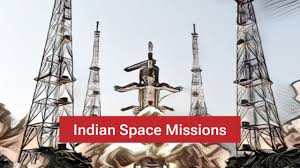India’s Space Ambitions: New Missions and Innovations Ahead
Syllabus:
GS-3:
Space Technology , Achievements of Indians in Science & Technology
Focus:
The advancements in India’s space missions, including plans for lunar and Venus explorations, showcase the nation’s growing capabilities in aerospace technology. The increasing collaboration with private companies indicates a strategic shift towards a more inclusive approach in space exploration, setting the stage for innovative discoveries and international cooperation.
New Ventures in Space Exploration:
- ISRO’s Expansion: The Indian Space Research Organisation (ISRO) is embarking on ambitious missions to Venus and the Moon, expanding its scope in space exploration.
- Private Sector Involvement: The private sector is increasingly involved in India’s space initiatives, focusing on satellite development and innovative propulsion systems.
- Upcoming Launches: Several significant projects, including the launch of NISAR and Proba-3 satellites, are on the horizon, demonstrating India’s commitment to advancing space technology.
Key Upcoming Missions of ISRO:
- Gaganyaan Mission (2026): India’s first manned space mission, marking a major milestone in the human spaceflight program.
- Chandrayaan-4 Sample Return Mission (2028): Aimed at returning lunar samples to enhance understanding of the Moon’s geology and resources.
- LUPEX/Chandrayaan-5 Mission (Post-2028): A collaborative project with Japan’s JAXA, featuring a 350-kg Japanese rover and an Indian lander to advance lunar science, with a goal of a human moon mission by
- NASA-ISRO Synthetic Aperture Radar (NISAR) Mission (2025): A joint India-US mission focused on monitoring natural resources and hazards through radar imaging, despite facing delays.
What is XPoSat Mission?
- Purpose: First dedicated scientific satellite by ISRO for space-based polarisation measurements of X-ray emissions.
- Focus: Research on celestial sources emitting X-rays.
- Significance: Enhances understanding of astrophysical processes and the behaviour of X-ray emissions.
What is Astrosat Mission?
- Purpose: India’s first dedicated astronomy mission.
- Capabilities: Studies celestial sources in X-ray, optical, and UV spectral bands simultaneously.
- Objective: Provides comprehensive insights into various astronomical phenomena and enhances knowledge in astrophysics.
Recent Approvals:
- Cabinet Initiatives: On September 18, the Union Cabinet approved four missions under the Gaganyaan human spaceflight program and additional missions to test technologies for the Bhartiya Antriksh Station, planned for completion by
- Financial Backing: The Cabinet allocated ₹11,170 crore for these four station-related missions and an extra Gaganyaan flight, supporting ISRO’s ambitious plans.
- Next Generation Launch Vehicle (NGLV): ISRO’s development of the NGLV received ₹8,240 crore in funding, aiming to create a versatile launch vehicle with private sector collaboration for operational flights.
Lunar and Venus Missions
- Chandrayaan-4 Mission: The upcoming Chandrayaan-4 will be a sample-return mission, launching components on two LVM-3 rockets, set to land near Chandrayaan-3’s location to collect lunar samples by 2027 at a cost of ₹2,104 crore.
- Venus Orbiter Mission: Slated for launch in March 2028 at a budget of ₹1,236 crore, this mission aims to study Venus’s harsh environment to understand planetary evolution across the Solar System.
- Joint Missions: A collaborative mission with Japan, the Lunar Polar Exploration Mission (LUPEX), is also in development, focusing on creating a new moon lander for future crewed lunar missions.
Space-Based Surveillance
- Enhanced Surveillance Initiatives: On October 11, the Cabinet Committee on Security approved the third phase of the Space Based Surveillance (SBS) missions, involving the construction of 21 satellites by ISRO and 31 by private firms, totaling ₹26,968 crore.
- Astronaut Training: India’s astronaut-designate Sudhanshu Shukla is undergoing training at SpaceX for the Axiom-4 mission, highlighting India’s growing capabilities in human spaceflight.
- Scientific Advancements: The NISAR satellite, a collaboration with NASA, is set for launch in early 2025, while Proba-3, studying the Sun’s corona, will launch on November 29.
Innovations in Private Sector
- Green Propulsion Technology: Manastu Space and Dhruva Space are collaborating to test green propulsion for the LEAP-3 mission, emphasising sustainability in space exploration.
- Ultra-Low Earth Orbit Development: Bellatrix Aerospace’s ‘Project 200’ aims to develop a prototype satellite operating at ultra-low Earth orbit, reflecting the private sector’s innovative spirit.
- Satellite Integration: Ananth Technologies became the first private Indian company to successfully assemble and test satellites for ISRO, marking a significant milestone in public-private collaboration.
Space Science Discoveries
- Chandrayaan-3 Insights: Recent findings indicate that the crater where Chandrayaan-3 landed is older than the South Pole Aitken Basin, underscoring the mission’s scientific value.
- Astrosat’s Extended Life: India’s first multi-wavelength observatory, Astrosat, has exceeded its expected mission life of five years and is projected to continue for another two years, contributing to over 400 published research papers.
- Innovative Research: Data from various missions is being leveraged to deepen our understanding of celestial phenomena, reaffirming India’s position in the global space community.
Challenges:
- Funding Constraints: While the Indian government has approved significant budgets for various missions, sustained funding will be necessary to maintain momentum and support new initiatives.
- Technological Development: The integration of advanced technologies, such as the Next Generation Launch Vehicle (NGLV) and green propulsion systems, presents challenges in terms of research, development, and successful implementation.
- Public-Private Collaboration: Ensuring effective collaboration between ISRO and private companies requires clear guidelines, incentives, and streamlined processes to encourage innovation while maintaining quality and safety standards.
- Training and Skill Development: As the space sector expands, there is a need for skilled professionals. Ensuring adequate training programs and educational initiatives is crucial to meet this demand.
- International Competition: With many countries advancing their space programs, India must innovate and enhance its capabilities to remain competitive on the global stage.
Way Forward:
- Strategic Partnerships: Foster collaborations with international space agencies and private sector players to leverage expertise, share resources, and enhance research capabilities.
- Sustained Investment: The government should ensure continuous funding for both public and private initiatives to encourage innovation and long-term growth in the space sector.
- Focus on R&D: Prioritise research and development to advance technologies that can be applied to future missions, enhancing India’s capabilities.
- Education Initiatives: Implement targeted educational programs in science, technology, engineering, and mathematics (STEM) to cultivate the next generation of space professionals.
- Robust Framework for Collaboration: Develop a clear framework for public-private partnerships to streamline processes, set standards, and promote shared goals in the space sector.
Conclusion:
India’s space program is entering a transformative phase, with plans for ambitious lunar and Venus missions, significant public and private sector collaboration, and enhanced capabilities in satellite technology and human spaceflight. These developments signify a robust commitment to exploring the cosmos and expanding scientific knowledge.
Mains Practice Question:
Analyse the implications of ISRO’s upcoming missions to Venus and the Moon on India’s position in global space exploration. How do public-private partnerships enhance the capabilities and efficiency of these missions?
Associated Article:
https://universalinstitutions.com/a-glimpse-into-ongoing-indian-space-missions/




